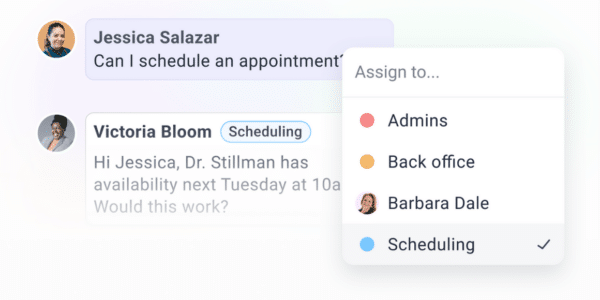Improving patient experience is something we are all striving for. Unfortunately there is no magic formula to make it happen.
Every facility is different, there are nuances to every population served, and there are countless factors for the individual that make improving patient experience really difficult.
While we are taking steps toward a value-based care model in the U.S., the current fee-for-service model means that patient practices are incentivized to get more patients through the door and to get them out quickly so they can be reimbursed. This simply isn’t a recipe for improving patient experience, as you might imagine.
As we continue to move toward a model where clinicians are reimbursed for providing and proving value for their patients, healthcare consolidation that is profit-driven is gaining more and more ground. Nowhere is this more apparent than the recent news that Amazon will be rolling out its healthcare offering to its employees this year in the form of Amazon Care.
This has many people, including us, asking what this means for traditional, brick and mortar patient practices. As a medical practice, how can you prepare for competition from one of the biggest companies in the world? OhMD CEO, Ethan Bechtel, sat down with John Lynn, Founder and Chief Editor of healthcareittoday.com, to discuss just that on our latest episode of “The Patient Conversation.”
They discuss thoughts on how to protect your practice from the disruption Amazon Care might bring while also meeting a growing demand for value-based care.
The time is now to begin preparing for competition with Amazon Care. By building your practice with the goal of improving patient experience, trust and loyalty, you’ll have a leg up on any competition that might arise in the future, whether it’s the practice down the street or a behemoth like Amazon.
What is the future for telehealth?
The COVID-19 pandemic came with an explosion in the use of telehealth.
Why? Three big and simple reasons.
One, patients still needed care.
Two, as it turns out, patients also loved the convenience of telehealth. The pandemic and the resulting surge in telehealth completely changed the patient experience and their willingness to engage with clinicians virtually. In fact, a 2019 study showed that just 11% of consumers were interested in telehealth options. By mid-2020, 76% of people said they were now interested in using telehealth in the future.
Three, patient practices and their clinicians had no other choice.
With people quarantining at home and doing everything they could to avoid exposure, clinicians had to either use telehealth, or see no one.
The choice was simple. Combining this with the fact that the technology was already available for many patient practices, just not widely used, you can understand why and how this meteoric rise occurred where we saw a 154% rise in telehealth visits the last week of March 2020 over the same period the previous year.
So, if patients love it and the technology to make it happen is readily available, we should see telehealth become a part of our day-to-day care journey post-pandemic, right?
Not so fast.
John Lynn says that while telehealth has had immense impact on improving patient experience, it hasn’t necessarily been a perk for providers.
That’s because providers don’t always get properly reimbursed for the telehealth services they offer patients. It will be an understandably tall order for practices to stay on board with offering telehealth services if they’re not being reimbursed appropriately for them, regardless if it has helped in improving patient experience.
Lynn says the continued growth of telehealth will require two key factors:
- Granting providers adequate reimbursement for telehealth services.
- Nailing down the best use case for each channel of communication with patients, from texting to video visits to in-person visits, in order to offer the best possible care to further in improving patient experience.
Using technology as a means for improving patient experience
Understanding the best use case for each telehealth channel that aids in improving patient experience will go a long way toward “building the moat,” so to speak, that will cement your practice as a patient’s trusted healthcare provider.
With any disruption or accelerated use of a new technology, there is always going to be some apprehension or even fear.
Take HIPAA compliant texting as an example. While it can enable a better patient experience and more consistent communication between the patient and provider, John Lynn says it’s not uncommon for providers to fear this enablement.
Providers might question whether patients will abuse improved access to their doctor or if it will increase the care team’s workload. “Helping to overcome those misconceptions with people is one of the most exciting things that I get to do,” says Lynn. There are always going to be people who use technology and services in a way that you would prefer they wouldn’t. That doesn’t mean you should stop delivering an amazing experience for 99% of your patients out of fear of how 1% of them might use it.
Solving for the patient need first and improving patient experience will help immensely in creating loyalty to your practice. Don’t fear it. Embrace it and you’ll be that much further ahead when you face competition in the future.
What will be the role of the care manager in the future of healthcare?
With increased usage of technology that connect patients to their providers, the amount of touch points also increases.
Doctors, in many cases, are no longer able to quarterback the entire spectrum of care the patient receives, as it comes from many sources and communication can come through many channels.
Care managers, who can coordinate patient care across specialists, are becoming vital. John Lynn references an article by Sunny Tara, founder of CareCognitics, in which Tara explains the growing influence of care managers (also known as care coordinators, case managers, and care allies) who all play a role in improving patient experience.
Tara says doctors have long been at the center of healthcare, but no longer have the bandwidth to check in with and manage care for so many patients in the way that care managers have been positioned to do so. Care managers provide a crucial link between patients and their providers, keeping patients on track with care plans and improving patient relationships through continuous, personalized outreach.
As value based care comes to the fore, making sure that each patient is supported through proactive outreach versus sporadic diagnostic treatment will set medical practices apart from their competitors. Not only will it improve care and outcomes and save on cost, but it will foster strong patient relationships necessary to grow your practice.
One potential impact of Amazon Care on improving patient experience
Amazon Care might actually mean good news for smaller scale medical practices and providers, according to John Lynn. Especially those that are using technologies that enhance the patient conversation.
He says Amazon Care has brought to light the many use cases for two-way patient texting in healthcare and can help to normalize its use on a huge scale.
Not every patient needs to be seen in person.
Not every patient needs to be seen over a video visit.
In fact, simply having a conversation with the patient through text or a call can answer many questions and alleviate patient fears while providing the opportunity to create a plan of action that is most appropriate whether it be a video or in person visit, if one is needed at all.
Practices can watch and learn from Amazon Care about the best methods for engaging with patients through the most appropriate channels and compete with them offering similar services.
This incentivizes practices to improve their patient communication technology to include things like texting and video visits for improving patient experience. By doing this, even when there is competition from other care providers, patients will be less likely to leave because they know they trust you as their care provider.
With Amazon Care on the horizon, how do I build relationships to retain my patients?
With that in mind, what else can you do to continue to build trust and loyalty with your patient population? Practices and providers should start to focus in on developing consumer-friendly practices to retain their patients. Patients want a relationship with their provider, but not necessarily with Amazon. What Amazon can offer is convenience.
Medical practices of all sizes can work to build for the patient, meaning improve patient communication, care, and therefore trust.
They can compete with the convenience offered by Amazon Care because they’re offering a more personalized patient experience.
If a patient has great care and a personal relationship with their primary care doctor, why would they want to switch to Amazon or any other healthcare provider?
Watch the full discussion
Watch the full video and read the transcript of “The Patient Conversation” with Ethan Bechtel and guest, John Lynn, of Healthcare IT Today.


